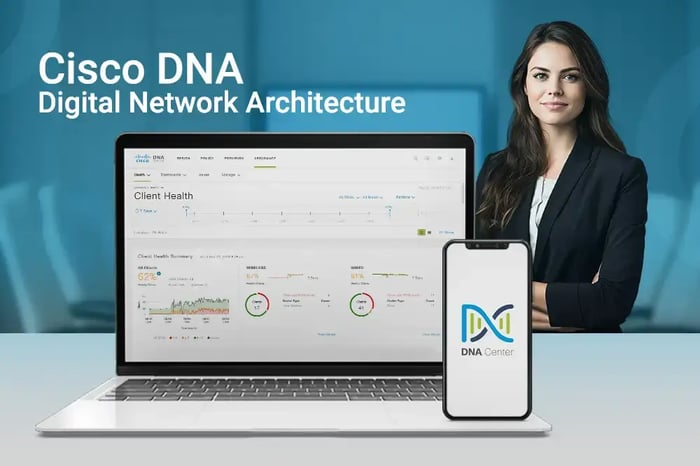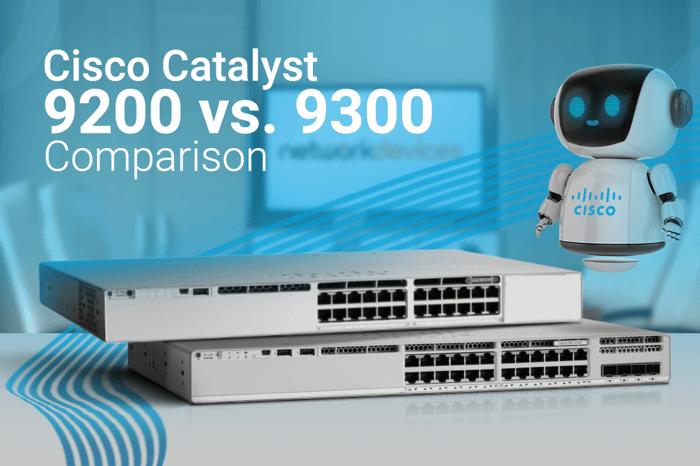You have no items in your shopping cart.

Cisco DNA - Digital Network Architecture
Cisco DNA, the first digital networking platform of Cisco, offers automation, extensibility, and security with SDN, SD-Access, SD-Wan, and IOS XE Software.
Cisco DNA Digital Network Architecture, the revolution in the network world
Cisco DNA Digital Network Architecture is the new trend in the networking industry. Accompanied by a bundle of outstanding features, it is stealing the light from all other vendors in favor of Cisco. So what is Cisco Digital Network Architecture DNA, and how does Cisco introduce it?
Per Cisco's official website, "Cisco DNA takes a software-delivered approach to automating and assuring services across your campus, WAN, and branch networks. Based on an open and extensible platform, DNA allows you to build value on the network to streamline operations and facilitate IT and business innovation."
So, let's explore each part of this definition and dive deep into its meanings and use cases.
First of all, what is the meaning of the Software-delivered approach?
The software-delivered approach means that this whole solution is based on the concept of Software Defined Networking (SDN) as the building block for those technologies. Most of us already know that SDN is based on abstracting the Control plane for the various network devices from the underlying hardware. Hence, SDN allows network devices to be directly programmed to dynamically and perfectly meet the varying requirements of applications transferred through those network devices.

Automation and Security
Coming to the second part of the definition of Cisco Digital Network Architecture DNA, automating and assuring services across your campus, WAN, and branch networks. How can such a fancy statement be made?! Again, the magic behind those features is in the Software Defined Networks SDN capabilities of the network devices. The control plane is abstracted from the underlying infrastructure, whether part of the campus, the WAN, or the branch.
Despite those platforms being so different in many aspects, such as performance and offered capabilities, using Software Defined Networks (SDN), they can act so similarly that the users can feel no difference in their experience while moving between those different environments.
This means the same experience for users working on-site, over the WAN from a distance, or even in SoHo environments over a VPN connection. The same expertise indicates the same Quality of Service QoS profiles and Access Control Lists ACLs, privileges, authentication and authorization methods, etc.

Open and Extensible Platform
The third part of the definition of Cisco Digital Network Architecture DNA discusses an open and extensible platform. This openness comes from the fact that the Cisco Digital Network Architecture DNA solution is:
- Based on open platform Application Programmable Interfaces APIs
- Featuring a lot of adapters and Software Development Kits SDKs, which assures that those platforms are programmable and software-centric and integrate with applications, systems, and domains beyond the network.
That's why Cisco considers this openness the fuel to innovation and focuses on the 360-degree extensibility provided by their Digital Network Architecture DNA solution.
 Considering the previously mentioned concepts, the last part of the definition of Cisco Digital Network Architecture DNA is self-explanatory. Cisco DNA's extensibility, automation, openness, and all the other features of the solution streamline IT operations.
Considering the previously mentioned concepts, the last part of the definition of Cisco Digital Network Architecture DNA is self-explanatory. Cisco DNA's extensibility, automation, openness, and all the other features of the solution streamline IT operations.
Using this solution, the required time to achieve network-related operation can be minimized from hours or even days to minutes while eliminating human-related errors by using user-friendly wizards and workflows.
Finally, let's explore the components of the Cisco Digital Network Architecture DNA solution and explain each of them briefly:
1. Cisco DNA Center: This component sits at the heart of the solution: a single dashboard to manage the entire Cisco Digital Network Architecture DNA solution. This dashboard does simplify network operations by providing network administrators with an intuitive workflow to make it easy to design, provision, and monitor the network.

Cisco DNA Center increases user satisfaction with a policy-driven onboarding experience, increases network uptime, streamlines IT, integrates with other domains, and supports 3rd party vendor devices.
2. Cisco IOS XE software: This relatively new operating system, the successor of the Cisco IOS operating system, is built with flexibility in the core to support programmability, controller-based automation, and serviceability.

3. Cisco Software Defined Access (SD-Access): Facilitates segmentation and automates user access policies by converting the previously separated wired, wireless, and Internet of Things IoT environments into one unified fabric, thus making the onboarding procedures much easier for both the administrator and the user himself, disregarding the device type or location.
4. Cisco Software Defined WAN (SD-WAN): This architecture allows the IT administrators to manage the WAN and the branches centrally as one entity, thus delivering better user experiences for applications on-premise or in the cloud. It helps achieve greater agility and cost savings through easier deployments and transport independence.
5. Cisco DNA Security: The Cisco Digital Network Architecture allows the usage of the network devices as sensors, which allows real-time analysis and intelligence and enables you to have more granular control to enforce policy and contain threats across the network.

6. Cisco DNA-ready devices: Those devices are built from the ground up with Cisco Digital Network Architecture DNA software capabilities in mind to move faster, more efficiently, and more securely. The Cisco Digital Network Architecture DNA capable devices include:
- Wireless access points APs and wireless controllers
- Switching platforms like new models from the Catalyst family, Meraki, and some Nexus card
- Routing platforms like the 4000 ISR, ASR, CSR, and Meraki families
Final Note
We at Network Devices Inc. pay special attention to those platforms among our versatile portfolio of Cisco products due to the previously mentioned great features and superior capabilities offered by the Cisco Digital Network Architecture DNA solution.
Considering many success stories of our happy customers who have already deployed those solutions, we hope that you will have the chance to take a look at these products, including:
· Cisco Catalyst 9300 Series Switches
· Cisco Catalyst 9400 Series Switches
· Cisco Catalyst 9500 Series Switches
· Cisco Catalyst 3650 and 3850 Series
· Cisco Catalyst 4500E Series + Supervisor 8E
· Cisco Catalyst IE Rugged 4000 Series
· Cisco 4000 Series Integrated Service Routers
· Cisco ASR 1000 Series Aggregation Service Routers
· Cisco Integrated Services Virtual Router
|
|
|
Request a Quote






